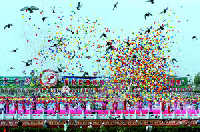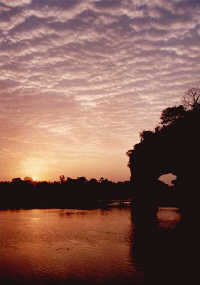| |
Bayangol Prefecture
( 2005-09-13 )
 The Bayangol Mongolian Autonomous Prefecture is located in the southeast of Northwest China'sXinjiangUygur Autonomous Region. It covers an area of 482,665 square kilometers, taking up 1/4 of the total area of Xinjiang. It is the largest prefecture in China, equaling the total area of China's eastern provinces of Jiangsu, Zhejiang, Fujian, and Jiangxi. Under it administration are eight counties and one city. The Bayangol Mongolian Autonomous Prefecture is located in the southeast of Northwest China'sXinjiangUygur Autonomous Region. It covers an area of 482,665 square kilometers, taking up 1/4 of the total area of Xinjiang. It is the largest prefecture in China, equaling the total area of China's eastern provinces of Jiangsu, Zhejiang, Fujian, and Jiangxi. Under it administration are eight counties and one city.
The prefecture has 41 ethnic groups -- like Mongolian, Uygur, Han, and Hui - with a total population of about 1 million, including 450,000 ethnic minorities. Korla City, the capital of the prefecture, is 471 kilometers to the north of Urumqi based on highway distance and 603.5 kilometers by railway.
Korla is a transportation center of southern Xinjiang and inland China. It has become a railway transportation hub serving inner-land provinces, and east, north, and south Xinjiang and has also become a central station for eastward, westward and southward air transportation.
The area has a continental climate, as it is located between the mesothermal (mid-thermal) and warm temperate zones, with favorable conditions for the planting of cotton and fruits. Korla City, located on the southern slope of the Tianshan Mountains and at the northeast edge of the Tarim Basin, is well known for its fragrant pears. The prefecture is also one of the main producing areas of cotton in Xinjiang and the largest producing base of tomato ketchup in China.
 In the prefecture, there are some rivers including the Tarim, Kaidou, Dinar, and Miran rivers, with an annual surface runoff of 106 hundred million cubic meters. In the prefecture, there are some rivers including the Tarim, Kaidou, Dinar, and Miran rivers, with an annual surface runoff of 106 hundred million cubic meters.
The natural pastureland area is 11 million hectares in area. The wild animals total 73 in species, and birds number 264 in kinds. There are more than 2,200 kinds of wild plants, including herbs like licorice. The antlers of various animals are also used for herbal purposes.
There are 58 kinds of ores, the bigger deposits of which are oil, natural gas, vermiculite, asbestos, manganese, dolomite, gypsum, limestone, andjadestone.
Despite natural scenic spots like the Bosten Lake, the Bayanbulak Grassland, the Taklimakan Desert, the Altun Mountain Nature Reserve, and the Yadan scenic spot, there are also many cultural relics sites, including the Tiemen Gate, the Ancient City ofLoulan, the Xikeqin Thousand Buddha Caves, the Remains of Miran, and the Yellow Lamasery in Baluntai, and so on.
|
|

